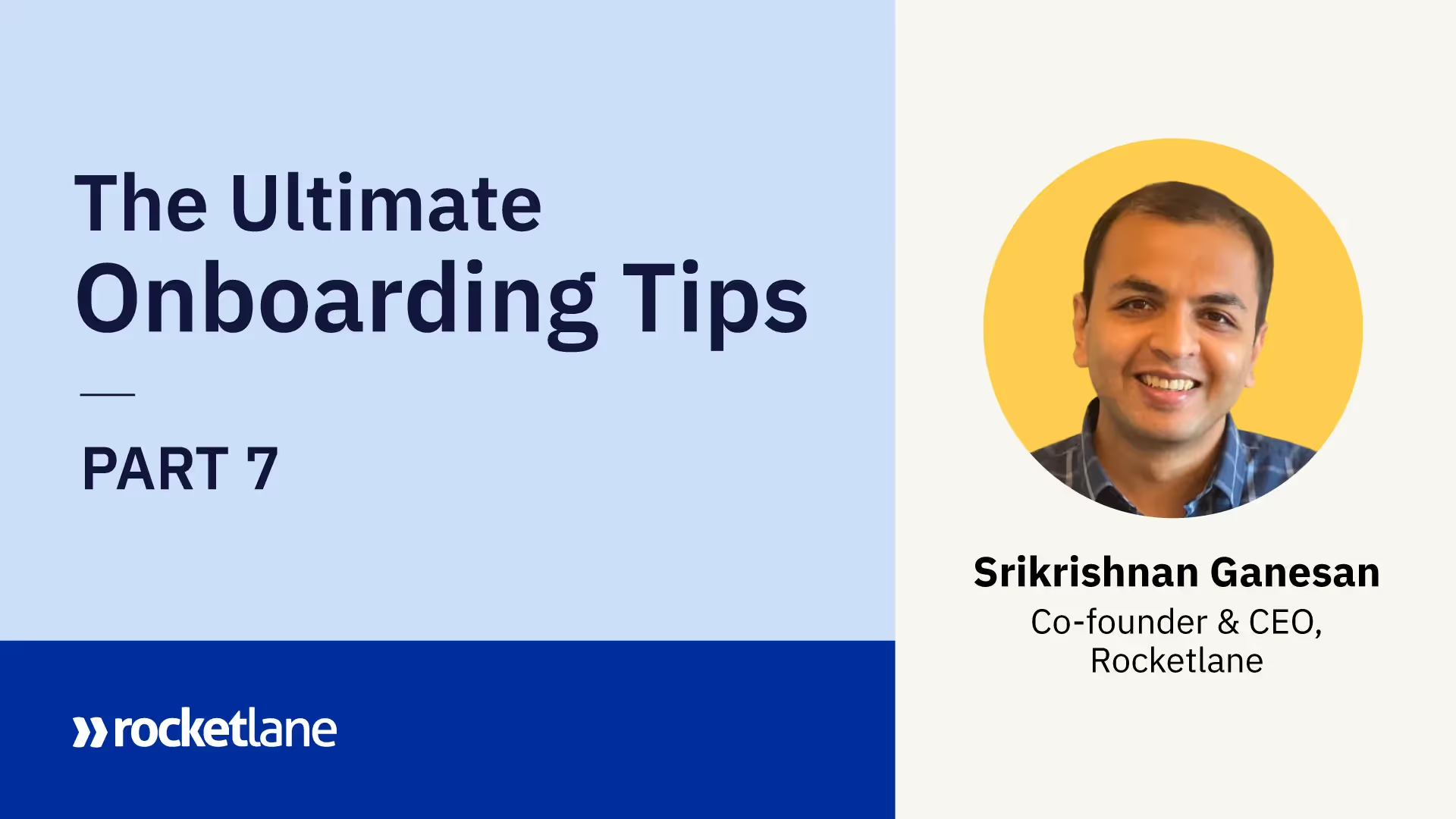Welcome to Part VII of the Customer Onboarding Tips series. In part VI, we discussed the importance of showing flexibility in your implementation plans, customer effort levels, and quarterly reflection meetings.
In this installment, we’ll learn why you should have an Onboarding Enablement Package, Onboarding Business Reviews, what hyper-care can do for your customers, and more.
Let’s jump straight in!
Tip #31: Onboarding Enablement Package
When we recently looked back at some of our most successful implementations and rollouts with customers, we noticed a pattern. In addition to what we did as part of our onboarding, these customers had done their own internal change management intentionally and effectively.
One of the learnings from these examples is that these customers put together some great internal wikis, a bunch of thoughtful emails, messages, etc., promoting the change. These wikis contained links to their own decks on their decision-making, pages introducing Rocketlane, introducing the benefits and value, as well as links to all our training material, call recordings, solution articles, etc.
This led to better buy-in and communication with their team, as they could all find this content easily in those internal wikis at any time and figure out how to access the Rocketlane academy, our articles, and the best practices session we did for them. If someone missed a meeting on why they chose Rocketlane, they could see the wiki page on the expected benefits and value to their company.
So this tip is essentially about creating Onboarding Enablement material for your customers' change management or operations teams. You can facilitate better change management for every customer by providing them with the material they need the most:
- Package training material, best practices session recordings, solution articles, etc., should be readily available in indexed and linked content that they can reuse or add to their wikis.
- Provide decks and content on value/benefits that they can add to internal wikis and other knowledge systems accessed by their team.
- Put together posters, email templates, Slack/Teams message templates, and sequences that make it easy for the folks driving change to modify and send out at the right cadence to their teams to create some buzz and momentum for adoption. These can cover specific exciting capabilities of your product and testimonials from early users/internal champions who are more bought in already, as well as benefits to the team and company to create some excitement.
- Maybe a care package or some swag that you can send out at the right time for the users adopting the solution.
So put together your Onboarding Enablement content and share your experiences, feedback, or other ideas with us at care@rocketlane.com!
Tip #32: Contextualize and "right-size" your training
Unless you are a very early stage product, SaaS products can get pretty complex or loaded with features over a period of time, making it hard to cover every element of your product capabilities while training a user during onboarding. Of course, we also know how all our attention spans in Zoom meetings have dwindled, and it's hard for people to process and retain too much information from a training session.
So how do you do a more effective training session during your onboarding?
If the customer's team is small, say five to ten people, it's easier to do an interactive session, get them all on video, discuss their day-in-the-life, and show them how they can accomplish the same activities on your tool.
For teams with more than ten members, here's our recommendation to right-size your training:
- Meet with two or three curious users beforehand and understand their "day in the life."
- Understand their top frustrations and top time-sink activities.
- Craft a training session for the larger user group focused on just the top activities they need to perform and showcase how your software helps with removing their frustrations or saves time.
- Ask questions like, "what do you spend the most time on each week?" so that the users engage and are actively thinking about their current pains.
As we shared in Onboarding tip #21, you can create mini videos and walk users through them.
Make sure to showcase your top three "wow" experiences relevant to the customer:
- Don't try to go through every detail of the product but make sure the customer can do their work.
- Remember you can help them bridge more gaps and learn more in subsequent meetings (like the Reverse Demo in Tip #8 or a separate best practices session that comes after they start using the product).
The goal should be to get people excited to use your software, see how their daily experience improves, and get comfortable doing their core work using your product. You don't need to think through all corner cases - just ensure the team knows how to reach your support if they need additional help while using the product.
Anything else you do that makes your training more effective during your customer onboarding journeys? Tell us at care@rocketlane.com
Tip #33: The "OBR"
This is not new for folks following Rocketlane or Preflight, but we realized that we hadn't covered this one in our series of Onboarding Tips. This tip concerns the importance of including an OBR, an Onboarding Business Review, at the end of your onboarding process.
We all know QBRs and how CSMs use them to align on the customers' key goals, discuss adoption, showcase ROI, and opportunities to unlock more value. We also know EBRs with the top executives on both sides - which are more high-level, focussed on affirming alignment between the customer's goals and vision and your own as a company, showcasing your product vision, the partnership status, ROI, and discussing the future of the partnership.
And then there are OBRs - which are not as common as QBRs and EBRs.
I came across OBRs sometime in 2020 when Aditya Maheshwari talked about them in one of our Preflight sessions. We also had Aaron Thompson talk about this at length at Propel 22.
So what is an OBR?
Onboarding Business Reviews are meetings you do just as you exit the onboarding with the customer. The idea is the review the partnership so far and set the path and priorities for post-onboarding success.
Some key elements that can go into the OBR:
- Celebrate the onboarding and adoption so far and key champions on both sides
- Identify what worked well and what did not in the partnership
- Lay out which onboarding goals have been accomplished
- Revisit priorities and the way forward - understand any gaps/misalignment identified during onboarding
- Set the tone for the future partnership with critical goals for the partnership
Want to learn more about OBR? We have two resources for you:
- Watch Aaron Thompson talk about OBRs at Propel - video and write-up
- Read about our Preflight sessions that touched upon this in the past here and here
Have other inputs for us? Join Preflight and start a conversation with the larger implementation and onboarding community.
Tip #34: Hyper-care
This is quite common for folks working with enterprise customers, yet we see many companies hand off to support and success immediately after going live.
We also see companies do hyper-care but not have it called out as a phase of their onboarding. There's more to gain than lose when you have an explicit phase defined for hyper-care. Let's understand why.
So what's hyper-care, and why should you do it?
- This is a 4-8 week period after go-live where you are closely engaged with the customer to fix problems, train, adjust configurations, etc., and ensure adoption and usage are smooth and problems seen are addressed in some way.
- The implementation/onboarding project team (solutions consultants, onboarding specialist, CSM, etc.) that executed the set-up and onboarding handles the customer queries and problems in this period - not customer service/support reps.
- Telling a customer asking about your onboarding journey that you have a hyper-care phase for two months after go-live is very comforting to the customer. It helps them believe in your team and work aggressively with you, knowing that you will be there to help them if something breaks after go-live.
What do you do during hyper-care?
- Have weekly catch-up sessions with the customer to help them bring up issues posing adoption problems or bugs stopping them from finding value from your offering.
- Capture all issues to be tackled neatly in task/issue lists to ensure you know how many post-implementation problems surfaced during hyper-care (a function of the quality of the implementation, training, etc.).
- Document all fixes and solutions provided to the customer during this phase for future customer reference and for internal teams to know the recommended processes, concerns, and how problems were fixed.
Do you do something different or unique during your hyper-care phase that you want to share? Tell us at care@rocketlane.com.
Tip #35: Set SMART + Aligned Goals at Kickoff
This tip is based on the conversation I had with Jan Young a while back.
Many of us are familiar with SMART as a tool for goal setting. Yet, we probably don't think of all the places where we can apply this. Goals shared at your onboarding kickoff should also be SMART - these are the goals you are setting to accomplish together in this vendor-customer partnership.
If you set SMART goals, you can easily verify if you were successful in achieving the goals, and everything about the goals is unambiguous.
For those who aren't familiar, SMART expands to "Specific, Measurable, Achievable, Realistic, and Timely." Here's an excellent post from Hubspot about how to set them with examples.
In addition to being SMART, for your customer onboarding to succeed and have the right priority, make sure each of the goals ties back to the corporate objectives in some way so that you can see and measure how they deliver value for the organization.
That concludes this edition of the Ultimate Onboarding Tips series. If you have any thoughts or feedback, do write to us at sri@rocketlane.com



















